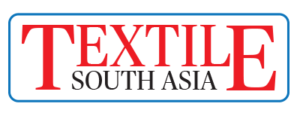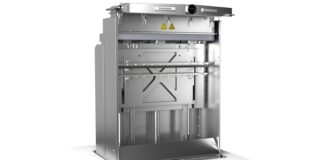
The Swiss Oerlikon Group’s Polymer Processing Solutions division will be presenting itself at the ITME 2022 under the banner of ‘From Melt to Yarn, Fibers and Nonwovens’. The international trade fair is taking place in the India Exposition Mart Ltd, Noida, close to New Delhi, India. Between December 8 and 13 this year, more than 1800 exhibitors and over 150.000 visitors are expected. Oerlikon will be presenting a broad range of products and services focused on manufacturing and processing manmade fibers. Oerlikon’s team of experts is very much looking forward to seeing you at booth C15 in Hall 11.
In addition to various new component exhibits from the fields of continuous polycondensation including gear metering pumps, filament (POY, FDY, IDY, BCF) and staple fiber spinning, and texturing as well as nonwovens production, the dialog with all customers will now more than ever after almost 6 years without an ITME in India be again at the center of the trade show activities.

Photo: Oerlikon
For Oerlikon, this will be the third major appearance in the region in the fourth quarter of this year, after having had in November two exciting and interesting customer events in Daman, India, and Dhaka, Bangladesh. This is also because the important markets of India and Bangladesh are currently still standing out in terms of their investment behaviour and currently offer good opportunities for further polymer processing projects. More than 250 participants discussed the technology and market analysis presentations held by Oerlikon experts, at the Oerlikon Technology Symposium in Daman, India. Afterwards, all guests celebrated the 100th anniversary of Oerlikon Barmag and the 75th independence of India with a big gala event.
India right now continues to have above-average economic growth with a 6.8% Gross Domestic Product (GDP) for 2022. Experts speak of “a bright spot in a global gloom”. Some facts and figures:
- The textile industry in India is one of the largest in the world with a large raw material base and manufacturing strength across the value chain.
- India is the 2nd largest producer of MMF Fiber. India is the 6th largest exporter of textiles and apparel in the world.
- India became the second-largest manufacturer of Personal Protective Equipment (PPE) kits in the world.
- India is the 6th largest producer of technical textiles with a 6% Global Share (12% CAGR), and the largest producer of cotton and jute in the world.
- The industry contributes to 7% of industrial output in value terms, 2% of India’s GDP, and 12% of the country’s export earnings.
- The share of textiles, apparel, and handicrafts in India’s total exports was 10.62% in 2021-22.
- The textile industry in India is one of the largest economic sectors that contributes the most to job creation in the country. It engages 16.73 lakhs of people consisting of 10.28 % of the total employment share.
- The domestic apparel and textile industry in India contributes 2.3% to the country’s GDP, and 7% of industry output in value terms.
- The domestic textiles and apparel industry stood at USD 152 bn in 2021.

Photo: Oerlikon
“Major growth of textiles will come from Manmade Fiber industry”, said Shri Piyush Goyal, Union Minister of Textiles, Consumer Affairs, Food & Public Distribution, and Commerce & Industry at the end of October in India. He suggested that the industry should understand each other and work in synergy to amicably resolve the issues among the producers and users of polyester in the entire value chain. Industry representatives responded that they are hopeful of achieving the export of 100 billion USD in the next 5 to 6 years.
Success in the markets
In India, however, things continue to go very well for Oerlikon in other respects. In the middle of the year, the joint venture Oerlikon Barmag Huitong (Yangzhou) Engineering Co. Ltd. also recorded a major success. Oerlikon was able to commission a 300 tons per day film-grade continuous polycondensation plant at the Indian customer Sumilon.
Sumilon Industries Limited started in 1970, with trading activity and the first manufacturing in 1977. Currently the largest manufacturer and exporter of metallic yarn and one of the leading manufacturers of BOPET film, metalized film, and lacquered film. Sumilon has always been committed to the goal that quality is everything, creating new technologies and enabling safer materials for all.
In fact, the COVID-19 pandemic has also had a serious impact on the project, such as project site installation, commissioning, start-up, and so on. But the teams of Oerlikon and Sumilon worked closely together, constantly exploring new train of thought, entirely guiding on-site installation and commissioning, remotely controlling the DCS system to run, and using modern means of hardware and software, the one-off start-up of 300T/D CP plant has been smoothly achieved, and the device is now stable in operation.
Growing with the second-largest exporter of textiles
Bangladesh still has huge potential, especially for the manmade fiber industry. In the so-called downstream (weaving, knitting, finishing, etc.), the country is already very advanced, but what is missing is its own raw material production (MEG, PTA) and its processing in a continuous polycondensation plant, as supplied by Oerlikon. With Modern Syntex, however, the first “From Melt to Yarn and Fibers” plant is currently being built in Chittagong, Bangladesh, under our leadership. Some facts and figures:
- With more than 164 million inhabitants, Bangladesh is the eighth-largest country in the world in terms of population. This makes it one of the most densely populated countries in the world.
- The economy of the up-and-coming country continues to grow rapidly, even during the Covid-19 pandemic, and the poverty rate has been halved since 2000. By 2026, Bangladesh will have officially left the status of a Least Developed Country (LDC), and by 2041, the country aims to become a high-income industrialized country (HIC).
- Bangladesh’s economic success is primarily based on its textile industry, which accounts for 10% of the gross national product and 80% of the export earnings.
- Bangladesh is the world’s second-largest exporter of textiles.
With a colorful and informative event, held in the capital Dhaka, more than 200 invited guests celebrated the 100th anniversary of Oerlikon Barmag and the 50th anniversary of the independence and liberty of Bangladesh. The Mayor of Dhaka, Md Atiqul Islam, emphasized the importance of the textile industry for his country and held out the prospect of further investments, especially in the field of manmade fiber production.







